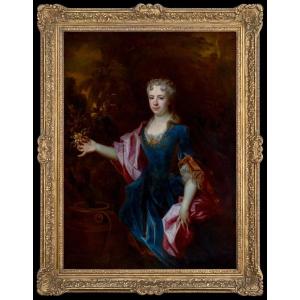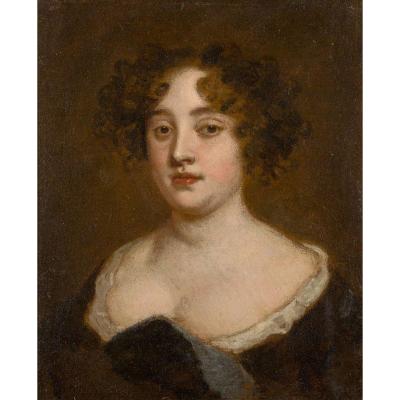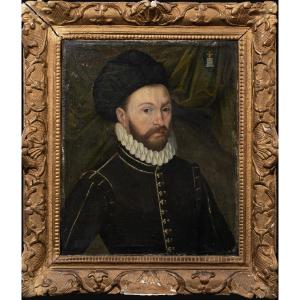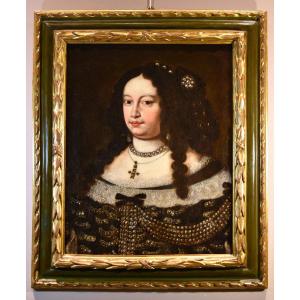Attributed to Cornelus van der Voort (c.1576-1624)
This exquisite oil on panel portrait depicts a young lady wearing the most elaborate and costly items of the period. The Dutch coif or coronet of sheer lawn with lace, the lavishly embroidered stomacher, and the exquisite ‘molensteenkraag’ or millstone collar made of batiste fabric are of the highest quality materials, and de rigueur for the wealthy individuals of society. The collar itself often requiring over 15 metres of fabric and an incredible effort to maintain. The whiteness of her skin serves as a marker of her social background and status, highlighting how physical appearance can often play a significant role in how individuals were perceived in society.
This portrait shows the precise, meticulously crafted, style for which the artist became well-known and is a fine example in its description of the sitter’s character and the careful reproduction of the face and fabrics. The well-preserved condition provides a unique opportunity for us to admire the intricacy and details of the attire that may not always be possible in portraits from a similar age. The dark pigments used to depict the expensive black silk, along with the intricate lace, have remarkably stood the test of time, allowing us to appreciate the craftsmanship and artistry that went into creating them four hundred years ago.
The gold pin worn in her hair on her left side indicates that she was engaged when the portrait was painted; married women wore the ‘betrothal pin’ on their right side.
Like rhetoricians, seventeenth-century artists were bound by rules and expectations for proper decorum, even in matters of dress. Costume was carefully chosen to suit the ideals of a particular culture or sitter and was used to convey a multitude of meanings. Knowledge of its associations and the history of costume can be crucial to the interpretation of portraiture.
The Dutch Golden Age of painting was a period in Dutch history, roughly spanning the 17th century, in which Dutch trade, science, military, and art were among the most acclaimed in the world. Dutch explorers charted new territory and settled abroad. Trade by the Dutch East-India Company thrived, and war heroes from the naval battles were decorated and became national heroes. During this time, The Dutch Old Masters began to prevail in the art world, creating a depth of realistic portraits of people and life in the area that has hardly been surpassed. The Golden Age painters depicted the scenes that their discerning new middle-class patrons wanted to see. This new wealth from merchant activities and exploration combined with a lack of church patronage, shifted art subjects away from biblical genres. Still lifes of items of everyday objects, landscapes, and seascapes reflecting the naval and trade power that the Republic enjoyed were popular. The large group portrait is also a standard subject often of a civic organisation. The new wealthy class were keen to have their portraits commissioned and thus many artists worked in this lucrative genre.
This portrait was in the famous collection of Dr. Paul Viktorovich Delaroff (1852-1913) who was a legal advisor based in St. Petersburg and Pavlovsk. He was the son of a Russian army general, he attended the Imperial School of St. Petersburg, earned a doctorate in law, and later taught civil law at the University of Kharkiv. However, he soon left academia to serve as an advisor at the Ministry of Public Works and eventually became a privy councillor to His Majesty the Emperor of Russia. Delaroff dedicated much of his life to the study of painting and engaged in art dealing on a large scale. Known for his charm and engaging conversation, he was a man of remarkable vitality. His extensive network enabled him to make several advantageous purchases and helped reignite interest in the Dutch school among Russian art enthusiasts. He amassed a vast collection of paintings, with some of his finest pieces loaned to museums in The Hague, Leiden, Berlin, and elsewhere. His impressive gallery of old master paintings was sold at auction in Paris during two sales in 1914, the first held on April 23-24, and the second from April 27 to May 2.
Contained within a good quality period frame.
Cornelis van der Voort, or van der Voorde (circa 1576 – circa 1624), was a distinguished Dutch portrait painter, art collector, art appraiser, and art dealer active during the early 17th century in Amsterdam. His oeuvre includes both individual and group portraits, notably the 'schuttersstukken' which portray members of local militias, and 'regentenstukken' depicting the regents of charitable institutions—a genre he notably pioneered. Van der Voort's contributions were instrumental in the evolution of portrait painting within the early 17th-century Dutch Republic, and he is particularly acclaimed for his introduction of the life-size, full-length format to the practice of Dutch portraiture. His oeuvre was highly sought after and regarded with great reverence. He significantly impacted the early portraiture of Rembrandt, as well as the works of Nicolaes Eliasz, Pickenoy, and Thomas de Keyser.
Little is documented regarding the early life of van der Voort. It is believed that he was born circa 1576 in Antwerp within the Habsburg Netherlands, as the son of Pieter van der Voort, who worked as a cloth weaver. In 1585, the van der Voort family relocated to the Northern Netherlands, presumably to escape the religious persecution in Antwerp due to their Calvinist beliefs.
It is thought that he trained under Cornelis Ketel and he had many pupils including David Bailly and the great painter, Nicolaes Eliasz. Pickenoy. In 1619, he was the Head of the Guild of St. Luke.
It is estimated that van der Voort fathered seven children and entered into matrimony twice: first in 1598 with Geertrui Willems, who passed away in 1609, and subsequently in 1613 with Cornelia Brouwers. He died in Amsterdam and was buried on 2 November 1624.
Inscriptions and Marks:
Red wax seal on verso “Collection / 1914 / Paul Delaroff”
Provenance:
The Collection of Dr. Paul Viktorovitch Delaroff (1852-1913), Saint Petersburg and Pavlovsk;
His sale, Hôtel Drouot, Paris, “LA TRES IMPORTANTE COLLECTION de Son Excellence feu Paul DELAROFF – Conseiller privè de Sa Majesté L'mperateur de Russe.” 2 May 1914. This painting is listed in the catalog under lot number 193 and described as: “Portrait de femme” with the corresponding dimensions of 49 x 37.5 cm
Measurements:
Height 90cm, Width 78cm framed (Height 35.5”, Width 30.5” framed)

































 Le Magazine de PROANTIC
Le Magazine de PROANTIC TRÉSORS Magazine
TRÉSORS Magazine Rivista Artiquariato
Rivista Artiquariato